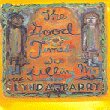|
|

Lynda Barry Cartoonist Lynda Barry didn't set out to write a novel in 1987. She'd just finished painting a series of portraits commemorating pioneers of American classical and indigenous music, and the gallery commissioning the series wanted her to write an essay accompanying the colorful folk art portrayals of such musicians as Ma Rainey, Otis Redding, and Jimmie Rodgers. Instead of penning a straightforward essay, Barry wrote a short novel about how music helped one girl negotiate the world around her in the 1960s, and The Good Times Are Killing Me was born. After languishing out of print for a few years while Barry was between publishers, Seattle-area small press Sasquatch Books has reprinted this important, if unlikely, cornerstone of both Young Adult lit and music criticism. The book starts out with a question worthy of a subject like these paintings. "Did you ever wonder what is music? Who invented it and what for and all that? And why hearing a certain song can make a whole time rise up and stick in your brain?" An inquiry rock critics like Greil Marcus and Ann Powers have grappled with in their body of writing, but Barry eschews the analytical approach for a more visceral look at early adolescence through the glare of a translucent red 45. We learn about Edna Arkins' life in pieces as the book unfolds; in her appealing first-person narrative, the importance of things like the record player her father brings home for her, piano lessons from a tyrannical old lady, the songs she sings to her baby nephew, and the songs from the old country her grandmother used to sing. Gradually things come into focus, and we learn that Edna is the elder child in a family that could best be described in 90s self-help lingo as "dysfunctional" -- her father is untidy about having an affair to the point where "he tells my mom he's going bowling and leaves the ball at home", and her mother starts falling apart after surviving a miscarriage. We also learn fairly early on that race matters in the insular culture of 1960s suburbia, and plays almost as big a role in her life as music. In the first chapter she reminisces of a time when "the houses on the street went white, white, white, Japanese, white, white", and we later glean of her family's double outrage when her cousin Ellen gets knocked up by a black man. As fate would have it, Edna strikes up a fast friendship with a black girl -- the tomboyish Bonna Willis, with whom she forms the Record Player Night Club. While race doesn't play a significant role in their relationship, the society in which they live underlines this point, and soon their friendship dissolves under the strains of the world around them. My first exposure to this work was through a Boston production of Steppenwolf Theatre's stage adaptation, in which the narrative was streamlined to focus mostly on Edna and Bonna. The book gets into Edna's head and gives you a good idea of how she thinks and feels. While this approach ultimately pays off, it takes a while to get used to. Barry writes the way a girl Edna's age thinks, in a style that's both stream-of-consciousness and never met a tangent it didn't like, and episodic, at times reading more like a series of interconnected short stories than a novel. There's also no connection made between Edna's story and the music notebook that concludes the book. I had to read an interview with Barry published years after the book was published and made into a stage play, and less enlightened audiences will be left wondering if the portraits represent artists who made it onto the Record Player Night Club's playlist or something. Along these lines, Edna's love of R&B and doo-wop music and dawning enlightenment to race issues could have opened up a potent narrative about how music has the potential to open communication between racial lines. However, It's doubtful that Edna could have made that connection. The Good Times Are Killing Me worked for me on two levels. As a former adolescent girl, this book hit me where I live while helping me see from a perspective I wouldn't normally consider, which all good art should do. As a writer who sees her music/art criticism work as an apprenticeship and needs to learn about good storytelling before she can tell her own tales, flipping through these pages reminds me to keep things clean and simple, and to remember how things like records can change people's lives. Copyright © 1998 Chelsea
|
| © 2011 Luna Kafé |